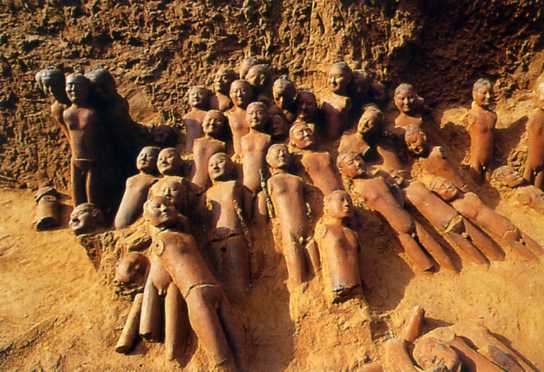Exploring the Western Han Dynasty mausoleums

The funerary pits of Yangling, the mausoleum of Emperor Jing of the Han Dynasty
At the Xianyang loess tableland areas of Shaanxi Province, mausoleums of 11 Western Han emperors and subordinate tombs are scattered everywhere. Baling, the mausoleum of Emperor Wen of Han, born Liu Huan, and Duling, the mausoleum of Emperor Xuan of Han, born Liu Xun, are on the southern bank of the Weihe River. Mausoleums of the other nine emperors line up from east to west on the northern bank of the river, stretching almost one hundred li, or 50 kilometers.
The construction and layout of these 11 mausoleums conforms to the concept of unity of man and nature by integrating man-made structures with the landscape, said Liu Junmin from the School of Cultural Inheritance at Northwest University.
The mausoleums are mostly arranged according to the same layout. According to historical documents, each mausoleum covers an area of 7 hectares, with the tomb being 12 zhang (a unit of length, equal to three and one-third metres) tall at the center. The underground chamber, 13 zhang deep under the ground, is a square. There are four doors at the center of the four side walls of the chamber, opening up to four roads on the ground. Then the four roads lead to the Sima Gate at the center of the wall on each side of the mausoleum. On each side outside the gate, there is a que, or watchtower.
Archeological findings have verified the truth of the historical records of these designs. The designs of imperial mausoleums in the Han Dynasty laid a foundation for and exerted great influence on later dynasties.
Five mausoleums of Han emperors are on the north part of Xianyang tableland: Changling of Emperor Gaozu; Anling of Emperor Hui; Yangping of Emperor Jing; Pingling of Emperor Zhao and Maoling of Emperor Wu. The five mausoleums and towns around them together formed the Wulingyuan, the tableland of five mausoleums.
Yangling of Emperor Jing, born Liu Qi, is situated at the east of Wulingyuan. The walls are ruined, gates are collapsed, and only the rammed earth base retains its original shape. In the Hanyangling Museum, visitors can see the archaeological scenes of funerary pits displayed under the cover of high-intensity tempered glass. The southern watchtower of the mausoleum is the best preserved among all Western Han Dynasty imperial mausoleums, and has the largest remnants of a rammed earth base.
The Western Han Dynasty was a prosperous and flourishing age during the earlier years of China’s feudal society. Jiao Nanfeng, former president of the Shaanxi Provincial Institute of Archaeology, said that because the Qin Dynasty only lasted 15 years, it was during the Western Han Dynasty that various laws and regulations of the feudal society were established and consolidated. Thus, valuable information pertaining to the Western Han Dynasty is preserved within the mausoleums.
The Western Han Dynasty was a peak period of human history around the beginning of the Christian era, said professor Duan Qingbo, from the School of Cultural Inheritance at Northwest University. The culture, politics, military thinking, philosophy, history and other aspects are all somewhat represented in the mausoleums of emperors of that period. These mausoleums are precious for investigating the world’s imperial mausoleums and they present Eastern and Western differences in this regard.
